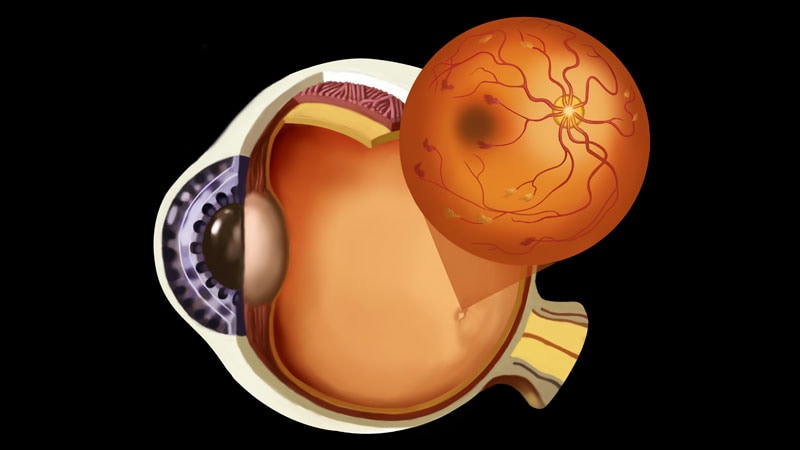Only about a quarter of patients with ocular hypertension lose peripheral vision, so clinicians should not recommend treatment to everyone with this condition, a long-term study suggests.
The 20-year results of the phase 3 Ocular Hypertension Study (OHTS) confirm that treating ocular hypertension reduces the risk for ocular nerve damage and visual field loss, but that the condition usually progresses slowly, giving clinicians and patients plenty of time to discuss options.

Michael Kass
“If you have a group of people who are, let’s say, in their 60s or 70s, 20 years is a pretty long time,” said Michael Kass, MD, professor of ophthalmology at Washington University in St. Louis. “And if only one out of four of them is going to develop visual loss, that’s reassuring.” The finding by he and his colleagues was published online April 15 in JAMA Ophthalmology.

Andrew Iwach
The study highlights the importance of doing a thorough baseline examination and watching closely to see how quickly patients are progressing toward primary open angle glaucoma (POAG), Andrew Iwach, MD, director of the Glaucoma Center of San Francisco, told Medscape Medical News. “I think it gives us the confidence and strength to wait and collect data and really individualize the therapy.”
For decades, experts have debated whether treating ocular hypertension early in its course can prevent full-blown glaucoma. The OHTS researchers set out not only to settle this argument, but also to identify the patients at highest risk.
In its original iteration — OHTS 1, conducted from 1994 to 1996 — the researchers randomly assigned 1636 participants with ocular hypertension to receive either topical ocular hypotensive medication or close observation. The participants were a mean of 55.4 years of age, with 56.9% female, 69.6% White, and 24.9% Black.
After 5 years, POAG was less common in the medicated group than in the observation group (4.4% vs 9.5%). The researchers found that a model that included age, intraocular pressure, central corneal thickness, vertical cup to disc ratio, and visual field pattern could accurately sort participants into low-, medium-, and high-risk categories.
In a follow-up study — OHTS 2, conducted from 2002 to 2008 — both of the original groups received medication to control their intraocular pressure. The researchers found that the incidence of POAG was about equal between the two groups. This suggests that the delay in treatment occurring in OHTS 1 didn’t cause any irreversible damage. “It wasn’t as if the train had left the station and that all of these people were going to have a bad outcome,” Kass told Medscape Medical News.
For the current study — OHTS 3, conducted from 2016 to 2019 — the researchers followed up with the 971 of the participants in the original cohort for whom they could get data to measure the incidence and severity of glaucoma. Of these, 29.5% developed POAG in one or both eyes.
Treatment was no longer based on the groups to which the participants had originally been assigned. After 20 years of follow-up, or within 2 years of death, 72.0% were receiving medication for ocular hypertension. Among those receiving medication, 81.4% were originally assigned to the medication group in OHTS 1 and 66.2% were originally assigned to the observation group.
After adjusting for exposure time, the researchers calculated that the 20-year cumulative incidence of the disease in both eyes was 45.6% among all participants, 49.3% among participants who had been in the observation group, and 41.9% among those who had been in the medication group in OHTS 1. The incidence of POAG was significantly higher among Black participants than among those of other races (55.2% vs 42.7%; P < .001).
The 20-year cumulative incidence of visual field loss was 25.2%. Looking at the 933 participants with reliable visual field data, the researchers found a wide range of visual field loss:
-
Among the 565 who did not develop POAG, the mean visual field mean deviation (MD) was –0.6 dB in the better eye and –2.2 dB in the worse eye.
-
Among the 62 who developed bilateral POAG visual field loss, the mean visual field MD was –1.5 dB in the better eye and –2.9 dB in the worse eye.
-
Among the 91 who developed unilateral POAG visual field loss and disc deterioration in the same eye, the mean visual field MD was –2.6 dB in the better eye and –7.4 dB in the worse eye.
-
Among the 63 who developed both bilateral POAG visual field loss and bilateral POAG disc deterioration, the mean visual field MD was –6.8 dB in the better eye and −12.6 dB in the worse eye.
The study validates the model that the OHTS researchers developed to stratify patients into risk categories, Kass explained.
The incidence of POAG was 31.7% in the one-third of participants estimated to be at low risk in the baseline model, 47.6% in the one-third estimated to be at medium risk, and 59.8% in the one-third estimated to be at high risk. These differences were statistically significant (P < .001). “Our suggestion is to use this risk model,” Kass said. The higher the risk, the more closely patients should be monitored and the more seriously they should consider treatment.
But other factors should be weighed when making this decision, he said. “You always have to consider the patient’s age, their health status, what you feel their life expectancy will be, and what their preferences are. Some people are very bothered by the high pressure psychologically and they want to be treated. Other people don’t want to take medicines unless they have to.”
JAMA Ophthalmol. Published online April 15, 2021. Abstract
Kass and Iwach have disclosed no relevant financial relationships.
Laird Harrison writes about science, health and culture. His work has appeared in national magazines, in newspapers, on public radio and on websites. He is at work on a novel about alternate realities in physics. Harrison teaches writing at the Writers Grotto. Visit him at www.lairdharrison.com or follow him on Twitter: @LairdH
For more news, follow Medscape on Facebook, Twitter, Instagram, and YouTube

